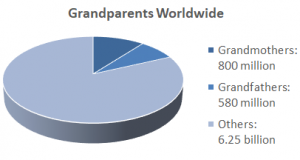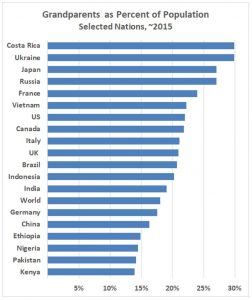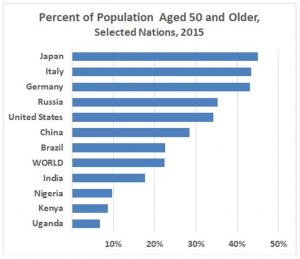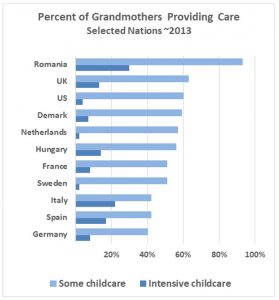Increasingly Indispensable Grandparents – Analysis
The world enjoys record-breaking numbers of grandparents due to longer lifespans and low fertility rates.
By Joseph Chamie*
Of the world’s 7.6 billion people, a record-breaking 1.4 billion, or 18 percent, are grandparents. Today’s grandparents play vital and increasingly indispensable roles in modern family life, contributing to the well-being of generations succeeding them. Grandparents have always been an integral part of family life. During the past half-century, however, their roles have evolved as result of demographic, economic, social and technological changes taking place worldwide.

The proportion of grandparents in a population varies across countries, depending on fertility rates and life expectancy, ranging from lows of around 15 percent in countries such as in Ethiopia, Kenya, Nigeria and Pakistan to highs in excess of 25 percent in Costa Rica, Japan, Russia and Ukraine. National statistics on grandparents, increasingly relevant for the development of family policies and programs, are unfortunately limited to a handful of developed countries. Consequently, the numbers and proportions of grandparents presented in this study are indirect estimates calculated by the author based on available demographic parameters for each country.
The proportion of women and men in a given population remaining childless reduces the potential future pool of grandmothers and grandfathers. In many developing countries, such as India, Indonesia, Pakistan, South Africa and Turkey, the proportion of childless women in their late forties is relatively low, typically below 5 percent. By contrast, in most developed countries, the proportion of childless women in their late forties is above 10 percent. In Austria, Canada, Finland, Spain, the United Kingdom and the United States, close to 20 percent of women reaching age 50 are childless.
The first childbirth of one’s offspring largely determines the age when people become grandparents. In some developed countries, such as Canada, Germany, Italy, Japan, Netherlands and Switzerland, the average age of women at first childbirth is close to 30 years, implying that the average age of grandmothers would be approximately double that age or about 60 years.
In many developing countries such as Bangladesh, Chad, Mali, Niger and Zambia, the average age of women at the birth of the first child is below 20 years. Accordingly, the average age of grandmothers would be roughly double that age or slightly less than 40 years.
The level of fertility also produces age structures that help determine the relative proportion of grandparents within a given population. In high fertility countries, such as Uganda, Kenya and Nigeria, less than 10 percent of the population is above the age of 50 years. In low fertility countries, such as Germany, Italy and Japan, more than 40 percent of the population is aged 50 years and older.
Another major demographic parameter contributing to higher levels and lengthier periods of grandparenthood is longevity, considered among the modern era’s greatest achievements. Notable gains achieved in health and lifespans provide women and men with more years to enjoy sustained relationships with grandchildren as they grow into adulthood. For example, at the start of the 20th century when life expectancy at birth in the United States was 47 years, about 20 percent of 30-year-olds had any living grandparent. By the close of that century, when life expectancy had increased to 77 years, about 80 percent of 30-year-olds had a living grandparent.

Living to advanced ages also permits increasing numbers of grandparents, especially women who generally live longer than men, to become great-grandparents, a relatively recent phenomenon.
The global number of centenarians, 80 percent being women, has tripled since the start of the 21st century. By the century’s close, the current number, about a half a million, is expected to increase 40-fold. Based on projected increases in longevity, one study estimated that by the year 2030, more than 70 percent of 8-year olds in the United States are likely to have a living great-grandparent.
A key familial role of grandparents in today’s modern world is providing childcare assistance to working couples and single-parent families. Although many relatives do not want to look after young grandchildren for health, financial or personal reasons, grandparents are the most common providers of informal childcare.
Largely due to the costs, unavailability and quality of formal childcare, absences and separations of parents, and normative attitudes and traditions concerning childcare, parents frequently rely on grandparents to care for grandchildren.
Such assistance often provides an indispensable lifeline to families squeezed by limited incomes, rising childcare costs, time constraints and employment demands.

The financial savings can be considerable. In the United Kingdom, for example, grandparents save parents more than $70 billion annually in childcare costs. In Australia, grandparents save working parents more than $2 billion annually in childcare costs. Such care is particularly critical for mothers with young children, especially single mothers, enabling them to enter and remain in the formal labor market. Without such support, many mothers could not participate in the labor market or pursue career goals.
Available studies show that grandmothers are more likely than grandfathers to provide childcare assistance and more time. For many developed countries, no less than 40 percent of grandmothers provide some childcare to their grandchildren. In the United States, the United Kingdom and Romania, the large majority of grandmothers provide some childcare.
Beyond providing childcare assistance, increasing numbers of grandparents are responsible for raising grandchildren on a full-time basis. For many reasons, including parents’ substance abuse and addiction, mental illness, incarceration, family breakdown, child neglect, migration and death, custodial grandparenting is a global phenomenon. In the United States, for example, about 2 percent of children are raised by grandparents with no parent living in the home. In many developing countries including China, Mexico, Moldova, Nigeria, the Philippines and Vietnam, parents who migrate for employment or resettlement to urban areas or abroad often leave children with grandparents and send remittances back home to support them.

More recently, the Great Recession and housing crises brought many generations together. In the United States, for example, the number of grandparents living with their grandchildren is up sharply, having increased by about a third over the past generation After a long post-war decline in households with multiple generations of family members living together, the proportion of multi-generational households in wealthy nations is once again increasing. This increase has been attributed to the economic conditions and growing numbers of foreign-born groups accustomed to living with extended families.
In addition to assisting children and grandchildren, many grandparents need care as they age. Most elderly prefer to live independently in their own homes as long as possible and not to become a burden for family members. However, growing numbers of aging grandparents, especially those with special needs, move near or in with children or to a facility providing assistance. Nearly 30 percent of those 85 years and older have dementia, with Alzheimer’s disease the most common form. Providing care to the elderly can be difficult and costly, taking a toll on the caregiver’s time and quality of life. Grandparents, adult children and grandchildren can anticipate and prepare for caregiving and end-of-life challenges.
Countries widely recognize grandparents’ essential roles in modern family life by officially celebrating Grandparents Day in Australia, Canada, Estonia, France, Germany, Italy, Mexico, Pakistan, Poland, Singapore, Spain, the United Kingdom, the United States and elsewhere. In addition to their unconditional love, grandparents offer guidance, emotional support and financial assistance to families, helping relieve economic, social and personal stress. Beyond their noteworthy contributions, grandparents receive considerable satisfaction from their roles, enjoying and benefiting being with family members.
*Joseph Chamie is an independent consulting demographer and a former director of the United Nations Population Division.

